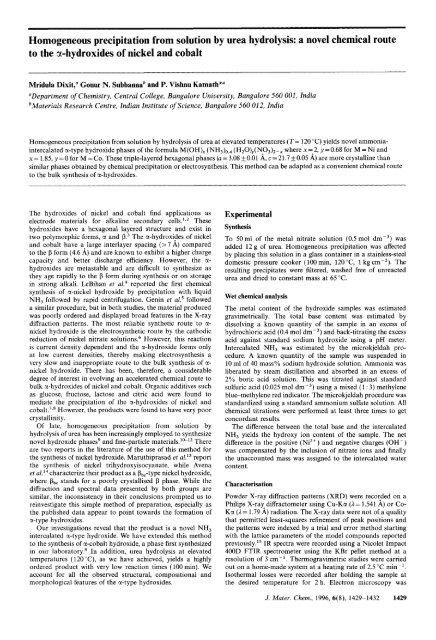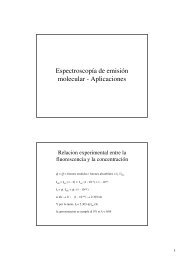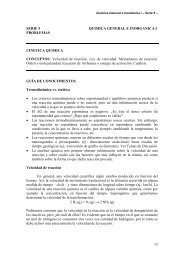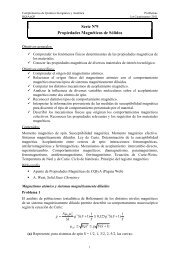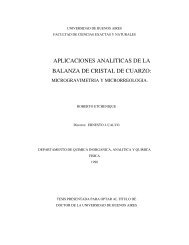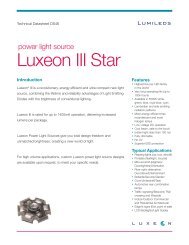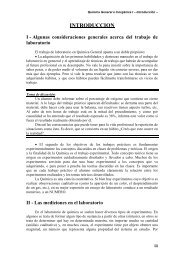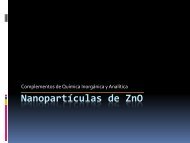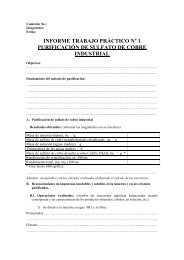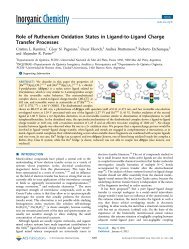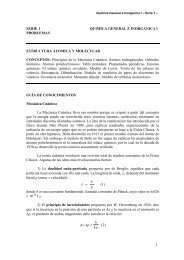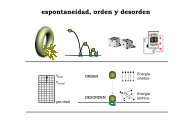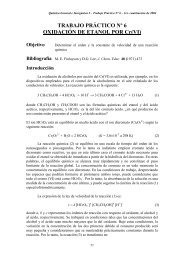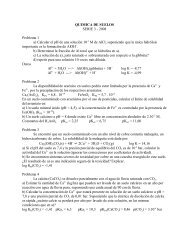Homogeneous precipitation from solution by urea hydrolysis: a ...
Homogeneous precipitation from solution by urea hydrolysis: a ...
Homogeneous precipitation from solution by urea hydrolysis: a ...
Create successful ePaper yourself
Turn your PDF publications into a flip-book with our unique Google optimized e-Paper software.
<strong>Homogeneous</strong> <strong>precipitation</strong> <strong>from</strong> <strong>solution</strong> <strong>by</strong> <strong>urea</strong> <strong>hydrolysis</strong>: a novel chemical route<br />
to the a-hydroxides of nickel and cobalt<br />
Mridula Dixit," Gonur N. Subbanna' and P. Vishnu Kamath""<br />
"Department of Chemistry, Central College, Bangalore University, Bangalore 560 001, India<br />
bMaterials Research Centre, Indian Institute of Science, Bangalore 560 01 2, India<br />
<strong>Homogeneous</strong> <strong>precipitation</strong> <strong>from</strong> <strong>solution</strong> <strong>by</strong> <strong>hydrolysis</strong> of <strong>urea</strong> at elevated temperatures (T= 120 "C) yields novel ammoniaintercalated<br />
a-type hydroxide phases of the formula M(OH), (NH,),,, (H,O),( N003), -x where x = 2, y = 0.68 for M = Ni and<br />
x = 1.85, y = 0 for M = Co. These triple-layered hexagonal phases (a = 3.08 & 0.01 A, c = 21.7 & 0.05 A) are more crystalline than<br />
similar phases obtained <strong>by</strong> chemical <strong>precipitation</strong> or electrosynthesis. This method can be adapted as a convenient chemical route<br />
to the bulk synthesis of a-hydroxides.<br />
The hydroxides of nickel and cobalt find applications as<br />
electrode materials for alkaline secondary These<br />
hydroxides have a hexagonal layered structure and exist in<br />
two polymorphic forms, a and p.3 The a-hydroxifles of nickel<br />
and cobalt have a. large interlayer spacing (> 7 A) compared<br />
to the p form (4.6 A) and are known to exhibit a higher charge<br />
capacity and better discharge efficiency. However, the a-<br />
hydroxides are metastable and are difficult to synthesize as<br />
they age rapidly to the p form during synthesis or on storage<br />
in strong alkali. LeBihan et uL4 reported the first chemical<br />
synthesis of a-nickel hydroxide <strong>by</strong> <strong>precipitation</strong> with liquid<br />
NH, followed <strong>by</strong> rapid centrifugation. Genin et aL5 followed<br />
a similar procedure, but in both studies, the material produced<br />
was poorly ordered and displayed broad features in the X-ray<br />
diffraction patterns. The most reliable synthetic route to a-<br />
nickel hydroxide is the electrosynthetic route <strong>by</strong> the cathodic<br />
reduction of nickel nitrate <strong>solution</strong>s.6 However, this reaction<br />
is current density dependent and the a-hydroxide forms only<br />
at low current densities, there<strong>by</strong> making electrosynthesis a<br />
very slow and inappropriate route to the bulk synthesis of a-<br />
nickel hydroxide. There has been, therefore, a considerable<br />
degree of interest in evolving an accelerated chemical route to<br />
bulk a-hydroxides of nickel and cobalt. Organic additives such<br />
as glucose, fructose, lactose and citric acid were found to<br />
mediate the <strong>precipitation</strong> of the a-hydroxides of nickel and<br />
cobalt.',' However, the products were found to have very poor<br />
crystallinity.<br />
Of late, homogeneous <strong>precipitation</strong> <strong>from</strong> <strong>solution</strong> <strong>by</strong><br />
<strong>hydrolysis</strong> of <strong>urea</strong> has been increasingly employed to synthesize<br />
novel hydroxide phases' and fine-particle<br />
There<br />
are two reports in the literature of the use of this method for<br />
the synthesis of nickel hydroxide. Maruthiprasad et report<br />
the synthesis of nickel trihydroxyisocyanate, while Avena<br />
et characterize their product as a Pb,-type nickel hydroxide,<br />
where Pbc stands for a poorly crystallised p phase. While the<br />
diffraction and spectral data presented <strong>by</strong> both groups are<br />
similar, the inconsistency in their conclusions prompted us to<br />
reinvestigate this simple method of preparation, especially as<br />
the published data appear to point towards the formation of<br />
a-type hydroxides.<br />
Our investigations reveal that the product is a novel NH,<br />
intercalated a-type hydroxide. We have extended this method<br />
to the synthesis of a-cobalt hydroxide, a phase first synthesized<br />
in our laboratory.' In addition, <strong>urea</strong> <strong>hydrolysis</strong> at elevated<br />
temperatures (12O"C), as we have achieved, yields a highly<br />
ordered product with very low reaction times (100 min). We<br />
account for all the observed structural, compositional and<br />
morphological features of the a-type hydroxides.<br />
Experimental<br />
Synthesis<br />
To 50ml of the metal nitrate <strong>solution</strong> (0.5mol dm-3) was<br />
added 12 g of <strong>urea</strong>. <strong>Homogeneous</strong> <strong>precipitation</strong> was affected<br />
<strong>by</strong> placing this <strong>solution</strong> in a glass container in a stainless-steel<br />
domestic pressure cooker (100 min, 120 "C, 1 kg ern-,). The<br />
resulting precipitates were filtered, washed free of unreacted<br />
<strong>urea</strong> and dried to constant mass at 65°C.<br />
Wet chemical analysis<br />
The metal content of the hydroxide samples was estimated<br />
gravimetrically. The total base content was estimated <strong>by</strong><br />
dissolving a known quantity of the sample in an excess of<br />
hydrochloric acid (0.4 mol drn-,) and back-titrating the excess<br />
acid against standard sodium hydroxide using a pH meter.<br />
Intercalated NH3 was estimated <strong>by</strong> the microkjeldah procedure.<br />
A known quantity of the sample was suspended in<br />
10 ml of 40 massoh sodium hydroxide <strong>solution</strong>. Ammonia was<br />
liberated <strong>by</strong> steam distillation and absorbed in an excess of<br />
2% boric acid <strong>solution</strong>. This was titrated against standard<br />
sulfuric acid (0.025 mol drn-,) using a mixed (1 : 3) methylene<br />
blue-methylene red indicator. The microkjeldah procedure was<br />
standardized using a standard ammonium sulfate <strong>solution</strong>. All<br />
chemical titrations were performed at least three times to get<br />
concordant results.<br />
The difference between the total base and the intercalated<br />
NH, yields the hydroxy ion content of the sample. The net<br />
difference in the positive (Ni2+) and negative charges (OH-)<br />
was compensated <strong>by</strong> the inclusion of nitrate ions and finally<br />
the unaccounted mass was assigned to the intercalated water<br />
con tent.<br />
Characterisation<br />
Powder X-ray diffraction patterns (XRD) were recor9ed on a<br />
Philips X-rayo diffractometer using Cu-Ka (A = 1.541 A) or Co-<br />
Ka (1 = 1.79 A) radiation. The X-ray data were not of a quality<br />
that permitted least-squares refinement of peak positions and<br />
the patterns were indexed <strong>by</strong> a trial and error method starting<br />
with the lattice parameters of the model compounds reported<br />
previ~usly.'~ IR spectra were recorded using a Nicolet Impact<br />
400D FTIR spectrometer using the KBr pellet method at a<br />
re<strong>solution</strong> of 3 cm- '. Thermogravimetric studies were carried<br />
out on a home-made system at a heating rate of 2.5 "C min-'.<br />
Isothermal losses were recorded after holding the sample at<br />
the desired temperature for 2 h. Electron microscopy was<br />
J. Muter. Chem., 1996, 6(8), 1429-1432 1429
~~ ~<br />
carried out using a JEOL 200 CX electron microscope Finely<br />
powdered samples were dispersed onto carbon mesh (size 200)<br />
for microscopic investigations<br />
Results<br />
In Fig 1A and B are shown powder XRD patterns of the<br />
samples obtained <strong>by</strong> homogeneous <strong>precipitation</strong> <strong>from</strong> nickel<br />
nitrate and cobalt nitrate <strong>solution</strong>s, respectively The prominent<br />
d spacings are listed in Table 1 together with those of a-nickel<br />
hydroxide obtained <strong>from</strong> the literature It is clear that the<br />
hydroxides obtained <strong>from</strong> homogeneous <strong>precipitation</strong> are a-<br />
type phases which c!n be indexed on triple-layered hexagonal<br />
cell (a= 3 08 +O 01 A, c=21 7_+005 A) In contrast, the more<br />
stable p-hydroxides obtained <strong>from</strong> conventionF1 chemica! synthesis<br />
have a much smaller unit cell (a= 3 10 A, c=4 76 A)<br />
As there has been considerable discussion in the literature<br />
on the presence of intercalated anions in the a-type hydrox-<br />
ides16 and especially among the products of <strong>urea</strong> <strong>hydrolysis</strong><br />
reactions,13 l4 a detailed chemical analysis of the samples was<br />
carried out, the results of which are summarised in Table2<br />
Estimation of the metal content clearly showed that the<br />
samples were anything but stoichiometric divalent hydroxides<br />
The observed metal content was much lower than what would<br />
be expected of a stoichiometric divalent hydroxide (63 3%),<br />
throwing open the possibility of the presence of several intercalated<br />
species The a-hydroxides generally contained significant<br />
amounts of intercalated anions with a matching deficiency in<br />
the hydroxy ion contentI6 The total base contents of the<br />
samples were therefore estimated using chemical titrations<br />
The results were quite surprising The hydroxides of both<br />
cobalt and nickel revealed a total base content in excess of<br />
what would be expected <strong>from</strong> the metal content As the excess<br />
base has to be of the neutral variety, the presence of intercalated<br />
NH,, a product of <strong>urea</strong> <strong>hydrolysis</strong>, was surmised Accordingly,<br />
microkjeldah estimations of ammoniacal nitrogen revealed the<br />
presence of up to 04 moles of NH, in both the hydroxides<br />
The difference in the chemical and microkjeldah estimations,<br />
which corresponds to the hydroxy ion content, was found to<br />
be stoichiometric for nickel hydroxide and deficient for cobalt<br />
Table2 Results of wet chemical analysis of the hydroxides obtained<br />
<strong>by</strong> homogeneous <strong>precipitation</strong> (hp)<br />
hp nickel<br />
hydroxide<br />
hp cobalt<br />
hydroxide<br />
e[ I I I<br />
lu<br />
Y<br />
15 35 55<br />
metal content (%) 51 9 55 1<br />
total base (Yo) 36 9 36 3<br />
NH, content (YO) 64 68<br />
net hydroxy content (YO) 30 6 29 6<br />
anion content (YO) 0 87<br />
water content (%) 109 0<br />
net mass loss (%) 32 8 (33 2) 24 8 (24 9)<br />
Values in parentheses are calculated on the basis of the proposed<br />
formula (see text)<br />
Table 3 Isothermal mass losses observed at different temperatures for<br />
the products of homogeneous <strong>precipitation</strong><br />
hp nickel hydroxide<br />
hp cobalt hydroxide<br />
I I I I I 1<br />
15 35 55<br />
2Bldegrees<br />
Fig. 1 A, Powder X-ray diffraction patterns of homogeneously precipitated<br />
nickel hydroxide (a) and nickel oxide, Ni0 (b) obtained <strong>by</strong><br />
thermal dccomposition of the hydroxide Data recorded using Cu-Ka<br />
(A= 1 541 A) radiation B, Powder X-ray diffraction patterns of<br />
homogeneously precipitated cobalt hydroxide (a) and cobalt oxide,<br />
Co,O, (b) obtained <strong>by</strong> thermal Gecomposition of the hydroxide Data<br />
recorded using Co-Ka (A = 1 79 A) radiation<br />
T/”C mass loss (YO) T/”C mass loss (YO)<br />
190<br />
230<br />
250<br />
270<br />
330<br />
370<br />
450<br />
36 150 36<br />
103 170 147<br />
20 7 190 20 6<br />
27 2 210 22 9<br />
30 0 310 24 8<br />
32 1<br />
32 8<br />
Table 1 X-ray powder diffraction data of the products of homogeneous<br />
<strong>precipitation</strong> (hp)<br />
loot<br />
I<br />
hp nickel hp cobalt<br />
hkP a-~l(~~),b hydroxide‘ hydroxided<br />
003 7 79 7 26 7 35<br />
006 3 908 3 616 3 612<br />
101 2 676 2 673 2 682<br />
012 2 604 - 2 598<br />
009 - 2 423 2 410<br />
015 2 321 - 2 282<br />
110 1541 1551 -<br />
“The observed patterns were indexed according tq these hkl planes %n<br />
a hexagonal cell bFrom ref 15 :a = 3 09 _+ 0 01 A, c = 21 77 f 0 05 A<br />
da=308+001 A, ~=2166+005A<br />
70t<br />
I I , I I<br />
0 100 200 300 400<br />
TIOC<br />
Fig. 2 TG data for homogeneously precipitated nickel hydroxide (a)<br />
and cobalt hydroxide (b)<br />
1430 J Muter Chem, 1996, 6(8), 1429-1432
hydroxide. The deficiency in the latter case was assumed to be<br />
made up <strong>by</strong> the presence of nitrate ions to achieve charge<br />
neutrality. The unaccounted-for mass was made up <strong>by</strong> the<br />
inclusion of water molecules. The analysis yields approximate<br />
molecular formulae Ni(OH)2(NH3)o 4(H20)0 68 and<br />
Co(OH), 85(NH3)o 4(N03)0 15 for the products obtained <strong>from</strong><br />
nickel and cobalt nitrate <strong>solution</strong>s, respectively.<br />
These formulae were verified <strong>by</strong> recording the isothermal<br />
mass losses of the samples at various temperatures (see Table 3).<br />
Both samples were decomposed completely <strong>by</strong> 400 "C, and the<br />
mass losses after decomposition matched those expected <strong>from</strong><br />
the above formulae (nickel sample: obs. 32.8%, exptd 33.2%;<br />
cobalt sample: obs. 24.8%, exptd. 24.9%). The expected mass<br />
losses were calculated based on the observation of the formation<br />
of Ni0 and Co304, respectively, as the products of<br />
thermal decomposition (see Fig. 1 for XRD data). However,<br />
these hydroxides showed a single-step dehydration and<br />
decomposition in their thermograms (see Fig. 2).<br />
In contrast, chemical analysis of a control sample of P-nickel<br />
hydroxide yielded the formula Ni(OH),, with a net isothermal<br />
mass loss of 18.1% (exptd. 19.4%), and a-nickel hydroxide<br />
yielded the formula Ni(OH)2(H,0)o,, with a total mass loss<br />
of 29% (exptd. 28.5%).<br />
In Fig. 3 the IR spectra of the samples obtained <strong>from</strong> nickel<br />
and cobalt nitrate <strong>solution</strong>s are shown. The spectra are typical<br />
of the a-type hydroxides which are described in detail elsewhere.16<br />
The only difference is the existence of an absorption<br />
at 2200 cm-l, which other authors13 have attributed to the<br />
existence of intercalated NCO- or CN- species in addition to<br />
the peaks due to intercalated nitrate anions seen in the<br />
1400-1000 cm-I region.<br />
In Fig. 4 the results of electron microscopic investigations<br />
1 I<br />
4000 3500 3000 2500 2000 1500 1000 500<br />
wavenumberkm<br />
Fig. 3 IR spectra of homogeneously precipitated nickel hydroxide (a)<br />
and cobalt hydroxide (b)<br />
on the samples obtained <strong>from</strong> nickel and cobalt nitrate <strong>solution</strong>s<br />
are presented. The nickel hydroxide sample shows a<br />
fibrillar turbostratic morphology [Fig. 4(u)]. The ring electron<br />
diffraction pattern taken <strong>from</strong> the same area at low magnification<br />
is shown in Fig. 4(b). However, the cobalt hydroxide<br />
particles are seen to have a needle-shaped morphology<br />
[Fig. 4(c)], and the corresponding electron diffraction pattern<br />
is sharp and spotty [Fig. 4(d)]. This is very much in contrast<br />
to the hexagonal platelet morphology seen among the p-<br />
Fig. 4 (a) Electron micrograph of homogeneously precipitated nickel hydroxide, (b) electron diffraction pattern of (a) (c) Electron micrograph of<br />
homogeneously precipitated cobalt hydroxide, (d) electron diffraction pattern of (c)<br />
J. Muter. Chern., 1996,6(8), 1429-1432 1431
hydroxides The turbostratic morphology is characteristic of<br />
the a-hydroxides<br />
Discussion<br />
Based on the observation of a strong absorption at 2200 cm-l<br />
in the IR spectra, Maruthiprasad et all3 characterised the<br />
product of homogeneous <strong>precipitation</strong> <strong>from</strong> nickel nitrate<br />
<strong>solution</strong> as nickel trihydroxyisocyanate [Ni2(0H),( NCO)]<br />
However, the IR spectra published <strong>by</strong> them contain equally<br />
strong evidence for the presence of intercalated nitrate ions, as<br />
do ours If intercalated anions are indeed present, based on<br />
charge neutrality considerations a matching deficiency in the<br />
hydroxy content can be expected However, chemical titrations<br />
reveal an excess base content Urea <strong>hydrolysis</strong> results in the<br />
formation of free NH,10-12 which under elevated pressures, as<br />
are obtained at 120 "C, can be expected to become intercalated<br />
within the hydroxide layers, leading to the ready formation of<br />
a-type phases The mole percentage of intercalated NH, is<br />
considerable, as revealed <strong>by</strong> the microkjeldah procedure While<br />
the cobalt hydroxide does show a 75% deficiency in the<br />
hydroxy content, the nickel hydroxide exhibits a stoichiometric<br />
hydroxy ion content It is our suggestion that the strong<br />
absorptions seen in the 1600-1000cm-1 region as well as at<br />
2200 cm-l arise <strong>from</strong> both intercalated and adsorbed species<br />
The X-ray diffraction data prove unequivocally that the<br />
phases obtained <strong>by</strong> homogeneous <strong>precipitation</strong> are a-type<br />
hydroxides The a-hydroxides are poorly ordered phases and<br />
exhibit broad bands in their X-ray diffraction patterns As a<br />
result, there is a considerable variation in the interlayer spacing<br />
reported <strong>by</strong> different authors3 The a phases obtained <strong>by</strong> us<br />
are rFasonably well ordered and the interlayer spacing observed<br />
(73 A) is less than the range of reported values l7 The<br />
presence of intercalated NH, in layered hydroxides is not<br />
unknown In the present instance, intercalated NH, appears<br />
to profoundly influence the thermal behaviour of the a-type<br />
hydroxides While a-hydroxides of nickel and cobalt are known<br />
to undergo multi-step mass losses,' l7 the samples obtained<br />
<strong>from</strong> homogeneous <strong>precipitation</strong> undergo a single-step dehydrationdecomposition<br />
reaction The observed mass loss agrees<br />
well with what is expected <strong>from</strong> the formulae obtained <strong>from</strong><br />
chemical analysis<br />
Electron microscopy results also show that the samples<br />
obtained <strong>from</strong> homogeneous <strong>precipitation</strong> exhibit a morphology<br />
more like the a-hydroxides, in contrast with the<br />
hexagonal platelet morphology of the 0-type hydroxides<br />
Conclusions<br />
We report here a simple chemical route to the bulk synthesis<br />
of a-hydroxides of nickel and cobalt <strong>by</strong> homogeneous <strong>precipitation</strong><br />
<strong>from</strong> <strong>solution</strong> <strong>by</strong> the <strong>hydrolysis</strong> of <strong>urea</strong> The phases<br />
which contain intercalated NH, are stable during synthesis<br />
and workup and this method can be adapted for the synthesis<br />
of nickel hydroxide positive electrodes for alkaline secondary<br />
battery applications<br />
Two of us (M D and P V K ) thank the Department of Science<br />
and Technology, Govt of India for financial support MD<br />
thanks the Council for Scientific and Industrial Research for<br />
the award of a Senior Research Fellowship<br />
References<br />
1<br />
2<br />
3<br />
4<br />
5<br />
6<br />
7<br />
8<br />
9<br />
10<br />
11<br />
12<br />
13<br />
14<br />
15<br />
16<br />
17<br />
18<br />
K Watanabe, T Kikuoka and N Kumagai, J Appl Electrochem,<br />
1995,25,219<br />
J Bauer, D H Buss, H J Harms and 0 Glemser, J Electrochem<br />
SOC , 1990,137,173<br />
P Oliva, J Leonardi, J F Laurent, C Delmas, J J Braconnier,<br />
M Figlarz and F Fievet, J Power Sources, 1982,8,229<br />
S LeBihan, J Guenot and M Figlarz, C R Acad Sci Ser C, 1970,<br />
270,2131<br />
P Genin, A Delahaye-Vidal, F Portemer, K Tekia-Elhsissen and<br />
M Figlarz, Eur J Solid State Inorg Chem , 1991,28, 505<br />
K C Ho and J Jorne, J Electrochem SOC , 1990,137,149<br />
P V Kamath, J Ismail, M F Ahmed, G N Subbanna and<br />
J Gopalakrishnan, J Muter Chem , 1993,3,1285<br />
J Ismail, M F Ahmed, P V Kamath, G N Subbanna, S Uma<br />
and J Gopalaknshnan, J Solid State Chem , 1995, 114, 550<br />
R J Candal, A E Regazzoni and M A Blesa, J Muter Chem,<br />
1992,2,657<br />
J L Shi and J H Gao, J Muter Sci, 1995,30,793<br />
K Kandori, M Toshioka, H Nakashima and T Ishikawa,<br />
Langmuir, 1993,9, 1031<br />
K Kandori, H Nakashima and T Ishikawa, J Colloid Interface<br />
Sci , 1993,160,499<br />
B S Maruthiprasad, M N Sastri, S Rajagopal, K Seshan,<br />
K R Krishnamurthy and T S R P Rao, Proc Ind Acad Scz,<br />
1988,100,459<br />
M J Avena, M V Vazquez, R E Carbino, C P DePauli and<br />
V A Macagno, J Appl Electrochem, 1994,24,256<br />
J J Braconnier, C Delmas, C Fouassier, M Figlarz, B Beaudouin<br />
and P Hagenmuller, Rev Chzm Mzner , 1984,21,496<br />
F Portemer, A Delahaye-Vidal and M Figlarz, J Electrochem<br />
Soc , 1992,139,671<br />
B Mani and J P deNeufville, J Electrochem Soc , 1988,135,800<br />
P Benard, J P Auffredic and D Louer, Thermochim Acta, 1994,<br />
232,65<br />
Paper 6/03062I, Received 30th April, 1996<br />
1432 J Mater Chem , 1996, 6(8), 1429-1432


